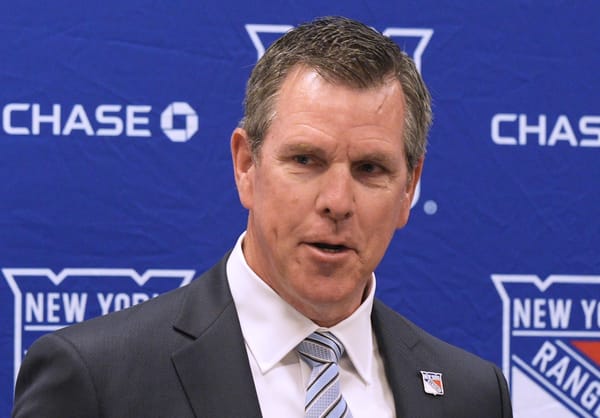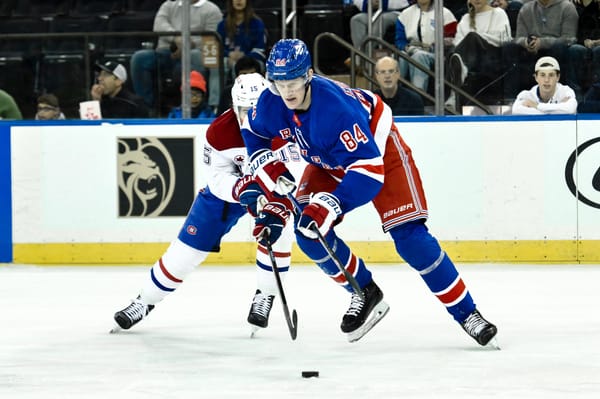2020 New York Rangers Draft Grades
Welcome to year six of draft day grades, everyone! Last year we celebrated our fifth anniversary with some Kaapo Kakko, and this year we’re celebrating our sixth anniversary with some Alexis Lafrenière! Then we’re … well … look, the draft ended up being really strange for the Rangers, that’s what I’ll say at the top.
Here’s the grades from the first four years:
As is tradition, I will now review my grades from last year’s draft.
I loved: Kakko, Karl Henriksson, and Zachary Jones. I thought the Rangers did such a good job last year of going after skill and talent regardless of size, and Henriksson and Jones were fantastic value picks as a result. Both Jones and Henriksson had solid post-draft seasons, and are in the process of beginning their D+2 years.
I liked: Matthew Robertson was a safe, reasonable selection at the time he was picked. My biggest issues (and what kept it from being a “loved” selection) was the talent on the board at the time. Still, Robertson was a fine selection where he was taken. Leevi Aaltonen was a great value selection in the fifth round, and followed up his draft selection with a full year in Liiga that saw iffy results. I also liked Adam Edstrom and Eric Ciccolini — although I thought Ciccolini was a better late “home run” swing than Edstrom was. Edstrom however had a good year in the SHL last year, while Ciccolini had a rough transition year in the NCAA. But again, late round picks are all gravy anyway.
I Disliked: Hunter Skinner. The only player who I really didn’t like in last year’s selection ended up having a much better year than expected. Skinner had 32 points in 62 games, and stood out on numerous occasions. That said, I’m still not sure there’s a path to the NHL for Skinner in New York.
I will give myself a B+ for last year overall.
Now onto this year.
Alexis Lafrenière (F) in the 1st Round (1st overall)
Related
What The Rangers Are (Probably) Getting in Alexis Lafreniere
Grade: A+++
Analysis: Last year I gave Kakko two “+” signs so I needed to up the ante here. Simply put, the Rangers finally got their franchise winger who should challenge for individual trophies year in and year out. While not on the level of Sidney Crosby, Lafrenière is the very next tier down, and should be one of the best wingers in the game.
There’s not too much to analyze here aside from the fact that the Rangers didn’t galaxy brain this and they got their guy.
Trading the 22nd and 72nd overall selections for the 19th selection
Grade: C-
Analysis: I had expected the Rangers to be an active trade up candidate in this year’s draft, dangling the 22nd overall and potentially Ryan Strome, Tony DeAngelo, or Alexandar Georgiev to do so. As some enormous names slipped toward the end of the top-10, I thought Jeff might try to make a move. When he didn’t, and Anton Lundell landed in Florida’s lap at 12 I was expecting the Rangers to trade down — maybe with San Jose for two second round picks.
So the trade up to 19 surprised me. The value, in a vacuum, was fine and in line with what you swap to move up to that position.
#22 traded for #19 and #71
— HockeyStatMiner (@HockeyStatMiner) October 7, 2020
Historic comparables:
#16 traded for #19 & #42 in 2007
#16 traded for #20 & #53 in 2006
#18 traded for #24 & #70 in 2007
#18 traded for #20 & #58 in 2013
#20 traded for #23 & #84 in 2009
Looks par for the course. God help us who they are picking.
The issue here is … why? There was plenty of talent falling that would have inherently been available at 22. And the pick …
Braden Schneider (D) in the 1st Round (19th overall)
Related
Braden Schneider Scouting Report: Analyzing the Rangers’ 19th-Overall Selection
Grade: B
Analysis: Schneider is an interesting prospect, with evaluations all over the board. ISS Hockey, as an example, has him as their 13th best prospect, McKeen’s Hockey had him 15th, and Bob McKenzie had him 17th. On the low end, Craig Burton had him 24th and Future Considerations had him at 21. Long story short, his selection at 19th wasn’t insane, and there are rumors the Leafs looked at him hard at 15.
That really doesn’t and shouldn’t matter all that much, but it does provide context.
Schneider is a shut-down defenseman who can throw in some offense and take care of his own zone. He’s a legitimate NHL prospect and should play at the NHL level for a long time. In a very, very loose comparable: Think Jacob Trouba with better skating but less offense. Matthew Robertson — last year’s 2nd round pick — is a very similar player, so why they felt the need to move up for a similar player to another prospect in the pipeline eludes me a bit and impacts the grade.
That there were other, better, higher-ceiling prospects on the board isn’t Schneider’s fault, but it does also impact the grade here. Connor Zary — who I thought was going to be the selection — Hendrix Lapierre, and Mavrik Bourque would have been outstanding value selections there.
Still, Schneider was one of four of Corey Pronman’s “consensus top-four” defenseman in the draft, and the Rangers knew the Devils were going to go for him at 20th — and that they then panicked that pick after losing out on Schneider is an added bonus. While there were better players on the board, Schneider is in no way a throwaway selection. It’s just far too safe of a pick for my liking after grabbing the best player in the draft. And trading up to do so was very strange, even if he would have been gone at 22.
Trading Lias Andersson to the LA Kings for the 60th Overall Pick
Related
Lias Andersson Traded to Los Angeles For The 60th Overall Pick
Grade: B
Analysis: When the trade happened there was a ton of “you just traded the 7th overall pick in 2017 for the 60th overall pick????” reactions. I myself was astounded the relationship with Andersson and the organization was so unsalvageable that they were moving him for a late second round pick in this year’s draft rather than trying to do a change of scenery swap. To be fair, the Rangers tried that to no avail last year, and it’s clear Andersson never saw himself returning to the Rangers.
All that said, the 7th overall pick in 2017 is not equal to the 7th overall selection in a draft three years later. Things change, and the longer the Rangers waited on moving Andersson the worse it was going to get.
In the scope of what ended up happening, the Rangers moved a player who was never going to play for them for a player they wanted.
Selecting Will Cuylle (F) in the 2nd Round (60th Overall)
Related
Will Cuylle Scouting Report: Evaluating the Rangers’ Second-Round Pick
Grade: C+
Analysis: Cuylle is an enormous body with a fantastic shot and a rough and tumble game. If this description sounds anything like Ryan Gropp — a guy who Gorton and Clark gushed about in 2015 and never made even an AHL impact — then you’d be dead on.
There are a ton of positives with a prospect like Cuylle. Betting on players with NHL-ready shots (although I wouldn’t go quite that far with Cuylle just yet) isn’t the worst move in the world. And when a guy doesn’t have outstanding hands in traffic, or a great ability to create space for himself, someone with size who can barrel his way into scoring areas isn’t bad either.
But boy oh boy did the Rangers pass on falling talent to get a guy that — once again — would have been there later in the draft, and if no so what. And much like Gropp, it feels like so much has to go right for him to be an NHL Impact player.
An enormous red flag is his lack of growth year-to-year in the OHL. As a rookie he posted 41 points in 63 games. In his sophomore year he posted 42 points in 62 games. He models his game after Tom Wilson which, fine, but for context Wilson went from 27 points in 49 games to 58 points in 48 games his next year.
Selecting Oliver Tarnstrom (F) in the 3rd Round (92nd Overall)
Related
2020 NHL Draft: New York Rangers Select Oliver Tarnstrom 92nd Overall
Grade: B
Analysis: Tarnstrom was a mostly unranked prospect — and where he was ranked it was in the mid 100’s. But there’s some pretty critical context to Tarnstrom that was noted by those who have eyes on Sweden. First, from our friends at Silver Seven Sens:
One of this draft’s bigger sleeper picks, Oliver Tärnström is a zippy forward who seems to be able to think the game at a similar speed. His 34 points in 41 games isn’t exactly standout, but he was the strongest play driver on one of the SuperElit’s weakest teams, elevating play of those around him. He’s also one of the draft’s youngest players as a late August birthday. Tärnström likely wouldn’t have been in this section without his hype. But if there’s any candidate in this piece to have a huge breakout year, it’s Tärnström.
Okay okay... I can definitely get behind that.... He produced a lot on a poor AIK J20, he was the main man there. https://t.co/MVnLh6GTTo
— Tobias Pettersson (@ManUtdTobbe) October 7, 2020
#92 Oliver Tärnström #NYR
— Christoffer Hedlund (@ChrHedlund) October 7, 2020
Smart two-way center that also can play on the wing. Has a good wrist shot. Decent playmaker that can hold on to the puck and find openings. Average skater that creates a lot from the perimeter. Good positional player and decent stickwork in his own end.
Following with the Rangers’ theme at this point in the draft: Probably picked a little high. There’s something to be said for one of the youngest players in the draft dominating for a middling junior team, and there might be more upside here than you might normally expect because of that, but a fine pick overall.
Selecting Dylan Garand (G) in the 4th Round (103rd Overall)
Related
2020 NHL Draft: New York Rangers Select Dylan Garand 103rd Overall
Grade: A
Analysis: Believe it or not, the Rangers’ goaltender pipeline was getting thin and they needed to address that. Yes, Igor Shesterkin and Alexandar Georgiev are young, yes Tyler Wall and Adam Huska are still in the system, but the timing of all four of those guys means little to the future.
Huska is 23 and Wall is 22. If and when Garand is ready to push for the NHL in, let's say, 4-5 years, those guys will be approaching UFA status (if even in the organization at all). https://t.co/40myssijzc
— Adam Herman (@AdamZHerman) October 7, 2020
Garand was a highly rated goaltender who is small and athletic in the crease. He got positive fanfare from almost everyone after he was picked.
Scoop on Dylan Garand from @TPEHockey (one of my go-tos for goalie prospect analysis): "Ya he’s a great goalie and a nice pick up in the fourth. Solid technical goalie, sharp reflexes. I’m definitely a fan. Had him in the 3rd, I think my 4th goalie"
— Drew Way (@Drews_Way) October 7, 2020
They're going to start flying off the shelves now, so to speak, but it's crazy that Dylan Garand still hasn't been picked, and I was expecting either Jan Bednar or Nick Malik to get picked somewhere around here. Also think no one is giving Amir Miftakhov enough love. https://t.co/hd6d8mwU0h
— Catherine Silverman (@catmsilverman) October 7, 2020
Dylan Garand is a threat to make Canada's WJC team.
— Steven Ellis (@StevenEllisTHN) October 7, 2020
Garand proved this season that he could handle a heavy 46-game workload and scouts have lauded his improved mental game for allowing him to take his game to a higher level. #NHLDraft
By all accounts Garand was great value at 103, and the Rangers got another goalie to add to the pipeline.
Trading the 196th and 206th picks for the 127th
Grade: A+
Analysis: This was a really tidy bit of work from Jeff Gorton here …
This actually looks to be very good value for NYR, going by history.
— HockeyStatMiner (@HockeyStatMiner) October 7, 2020
196 + 206 typically gets you in the 140 - 170 range. https://t.co/RjgMerZFMp
And it allowed the Rangers to make two selections in the 5th round where they suddenly reversed course and managed to grab major steals.
Selecting Evan Vierling (F) in the 5th Round (127th Overall)
Related
2020 NHL Draft: New York Rangers Select Evan Vierling 127th Overall
Grade: B+
Analysis: Vierling was excellent value at 127th, getting ranked anywhere from as high as 44th (Button/TSN) to 90th (Bob McKenzie). A two way scoring threat, Vierling jumped from 27 points in 60 games as a rookie in the OHL to a 14-30-44 stat line in 43 games this year between Flint and Barrie. After being traded to Barrie he notched 34 points in 28 games.
Amazing pick! Vierling is one of the best playmakers in the draft.
— Ben Misfeldt (@BBMHockey) October 7, 2020
I had him ranked #46! https://t.co/FBDuhnNt2C
Very nice pick in Evan Vierling. Had him as a guy I thought would go around round 3. HE is a great example of why i push back at going after grit super early. He is a gritty, two-way kid who also I think definitely has the talent to make the NHL. Very nice pick
— Drew Way (@Drews_Way) October 7, 2020
Selecting Brett Berard (F) in the 5th Round (134th Overall)
Related
2020 NHL Draft: New York Rangers Select Brett Berard 134th Overall
Grade: A
Analysis: Of the two steals the Rangers truly made in this draft, Berard is the best one. To grab him at 134th was incredible value — with almost all of his draft rankings falling between 40th and 68th. As one of the youngest players in the draft, his skills are enticing.
He’s on the smaller side, but there’s offensive upside here that should hype you up about Berard. He’s exactly the type of talent you swing hard on when you’ve already made the best picks in the draft.
Brett Berard is FANTASTIC value here. Was one of my favorite targets for the #NYR 3rd round picks. Small but extremely gifted winger with a high motor and very decisive. Very good puck handler and also better defensively than he generally gets credit for. Great value here
— Drew Way (@Drews_Way) October 7, 2020
2020 NHL Draft Rankings: my Top-31!#NHLDraft #2020NHLDraft #HockeyTwitter pic.twitter.com/Z7mreNRsZu
— Mikael Nahabedian (@hunterofstats) September 30, 2020
Selecting Matthew Rempe (F) in the 6th Round (165th Overall)
Related
2020 NHL Draft: New York Rangers Select Matthew Rempe 165th Overall
Grade: C
Analysis: By the time you get this deep in the draft the goal should be to swing as hard as you can on guys regardless of how much of a project they are. And oh boy us Rempe a project.
On Matthew Rempe:
— Sam Stern (@SternScouting) October 7, 2020
* Joel is smart. Listen to Joel when he types/talks/sings#NYR  https://t.co/4s7OS12L2S
Others aren’t so high on him.
Matt Rempe is… big. He’s gigantic. His hands in traffic are surprisingly good.
— Rhys Jessop (@Thats_Offside) October 7, 2020
The rest of his game… oh boy. It’s just not draftable.
But again, it’s the 6th round. Take yo projectzzz.
Selecting Hugo Ollas (G) in the 7th Round (197th Overall)
Related
2020 NHL Draft: New York Rangers Select Hugo Ollas 197th Overall
Grade: D
Analysis: The last pick of the draft is another project, this time a goaltender. This time also enormous. Ollas is 6’8” and uses his size to his advantage. The NHL has started shifting away from bigger goalie, but Benoit Allaire is magic after all.





